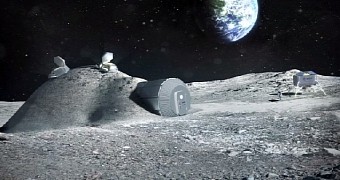It's safe to say that it will be years, decades even, before we send 3D printers big enough and far enough in space for them to actually be useful in the establishment of off-world colonies. That doesn't mean we can't cheat though.
It's true that when you say “3D printing in space” you're supposed to think of a 3D printer capable of 3D printing things in space.
This is actually already happening, as a zero-gravity 3D printer was successfully delivered to the International Space Station a few weeks ago.
However, that's still a pretty small contraption, good for little figures and maybe the occasional tool, but not much else. Especially when plastic is the only thing it can process.
Now, though, the European Space Agency has come up with a way that will allow it to 3D print moon bases without actually going to the moon to do it.
How to 3D print a moon base in a few easy steps
Well, truth be told, the steps probably aren't all that simple. Still, if the European Space Agency decides that it's possible to print a moon base, it's possible to print a moon base.
Here’s how it's supposed to go. First a lunar lander is sent to the moon's south pole, Shackleton Crater, with an attached cylinder.
Materials are sent later and expanded through 3D printing. Robotic 3D printers would be sheltered in an inflatable dome.
With the cylinder unloaded and cylinder deployed, the dome would become a support structure or scaffolding, on which the robots build the habitat by scooping up moon soil and building the actual dome over the bubble.
The shell would be light but very strong, compared to the bones of a bird. Since the moon has a low enough gravity the impacts will be much weaker than on Earth, as well as weight in general, this should be more than enough for people.
The plan for the hypothetical moon base
The plan is to have four people living there, with light received thorough skylights that would nonetheless shield them from radiation or meteorite threat. Not quite sure how that last one will work out if anything really big shows up, but from what we've heard, there aren't many large asteroids on a course that will bring them close to the Earth or its natural satellite.
The only thing that ESA would have to be really careful with is transporting the binding fluid meant to mix with the moon soil (regolith). There's an alternative though: sunlight could provide the power needed to melt the regolith.

 14 DAY TRIAL //
14 DAY TRIAL // 